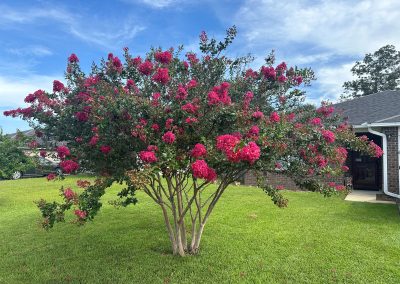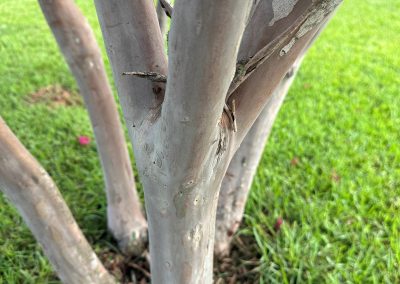Despite being a near-perfect ornamental for the Panhandle, Crape Myrtle is often misused. Though there are dozens of commercially available varieties in all shapes and sizes, many people choose the wrong one for their yard. The most commonly sold cultivars ‘Natchez’ (white flowers), ‘Muskogee’ (pink flowers), and ‘Tuscarora’ (watermelon red flowers) – all three attain mature heights more than 20’ – are almost always too large for siting near a house or other structure and are often out of scale with landscapes. The simple solution to making the best use of Crape Myrtle in smaller yards (certainly not dramatic pruning – Crape Murder is among the worst landscape sins), is to select a smaller growing variety and ‘Tonto’ is a personal favorite in this category.
-

10-year old 'Tonto' Crape Myrtle near mature size. Photo courtesy Daniel Leonard.
-

Fuchsia pink 'Tonto' flowers. Photo courtesy Daniel Leonard.
-

Cream colored exfoliating 'Tonto' bark midsummer. Photo courtesy Daniel Leonard.
‘Tonto’ Crape Myrtle, one of the selections that emerged from Dr. Don Egolf’s Crape Myrtle breeding program at the U.S. National Arboretum over 50 years ago, is among my favorite Crape Myrtle varieties for several reasons. First, Tonto’s fuchsia hued flowers are as vibrant as flowers come; they practically glow in the landscape. The flower show lasts for several months and are a valuable food source for pollinators, bees in particular, in the late summer when few things are blooming. Tonto also is a relatively slow grower that only reaches about 10’ tall and wide at maturity. This allows the variety to be exceedingly versatile in landscapes as it can be used in the background of planting beds, as a specimen plant, limbed up as a small tree in open areas, or even placed in very large containers. Finally, beyond just the flower show and ideal size, ‘Tonto’ has uniquely attractive, cream colored, exfoliating bark and reliably attractive fall foliage. Both these features add interest to landscapes, even when ‘Tonto’ isn’t flowering.
Though ‘Tonto’ sports many unique qualities, it shares many other excellent traits and growing preferences with its Crape Myrtle kin. For best results growing any Crape Myrtle, trees should always be sited in full sun, at least 6-8 hours a day. Shading will result in greatly reduced flowering and lanky plants. Regular watering during the first year after planning while trees are becoming established is helpful, as is periodic fertilizer application. Once established, ‘Tonto’ and all other Crape Myrtles are exceedingly drought tolerant and can get by on their own with minimal inputs from gardeners.
If you’ve been struggling with a Crape Myrtle that has outgrown its site or thinking about planting a new Crape, I’d encourage you to give ‘Tonto’ a look. It’s an outstanding shrub/small tree, will reward you with flaming fuchsia flowers and smooth cream-colored bark each summer, and will never outgrow its space. Plant one today! For more information on growing Crape Myrtles or any other horticultural topic, contact us at the UF/IFAS Calhoun County Extension Office. Happy gardening.
- Mulch is a Must in Your Landscape - December 4, 2025
- Tis the Season – Why Winter is the Best Time to Plant Trees and Shrubs - November 26, 2025
- Feeling Blue (Ginger) This Fall - November 13, 2025
